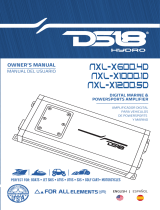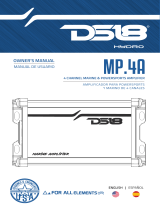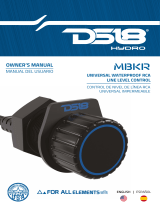DS18 G1800.1D El manual del propietario
- Categoría
- Amplificadores de audio para automóviles
- Tipo
- El manual del propietario
El DS18 G1800.1D es un amplificador de audio de clase D para automóvil que ofrece una potencia máxima de 1800 vatios a 1 ohmio, con una respuesta de frecuencia de 20 Hz a 20 kHz y una relación señal/ruido de más de 90 dB. Cuenta con un filtro de paso bajo variable de 50 Hz a 250 Hz, un filtro subsónico de 10 Hz a 50 Hz y un control remoto de nivel para ajustar el nivel de salida. Además, incluye protección contra cortocircuito, sobrecalentamiento y voltaje alto/bajo, lo que lo hace una opción confiable y duradera para sistemas de audio de alta potencia.
El DS18 G1800.1D es un amplificador de audio de clase D para automóvil que ofrece una potencia máxima de 1800 vatios a 1 ohmio, con una respuesta de frecuencia de 20 Hz a 20 kHz y una relación señal/ruido de más de 90 dB. Cuenta con un filtro de paso bajo variable de 50 Hz a 250 Hz, un filtro subsónico de 10 Hz a 50 Hz y un control remoto de nivel para ajustar el nivel de salida. Además, incluye protección contra cortocircuito, sobrecalentamiento y voltaje alto/bajo, lo que lo hace una opción confiable y duradera para sistemas de audio de alta potencia.




















-
 1
1
-
 2
2
-
 3
3
-
 4
4
-
 5
5
-
 6
6
-
 7
7
-
 8
8
-
 9
9
-
 10
10
-
 11
11
-
 12
12
-
 13
13
-
 14
14
-
 15
15
-
 16
16
-
 17
17
-
 18
18
-
 19
19
-
 20
20
DS18 G1800.1D El manual del propietario
- Categoría
- Amplificadores de audio para automóviles
- Tipo
- El manual del propietario
El DS18 G1800.1D es un amplificador de audio de clase D para automóvil que ofrece una potencia máxima de 1800 vatios a 1 ohmio, con una respuesta de frecuencia de 20 Hz a 20 kHz y una relación señal/ruido de más de 90 dB. Cuenta con un filtro de paso bajo variable de 50 Hz a 250 Hz, un filtro subsónico de 10 Hz a 50 Hz y un control remoto de nivel para ajustar el nivel de salida. Además, incluye protección contra cortocircuito, sobrecalentamiento y voltaje alto/bajo, lo que lo hace una opción confiable y duradera para sistemas de audio de alta potencia.
en otros idiomas
- English: DS18 G1800.1D Owner's manual
Artículos relacionados
-
 DS18 ZR500.1D El manual del propietario
DS18 ZR500.1D El manual del propietario
-
DS18 Candy-6 El manual del propietario
-
 DS18 NXL-X600.4D El manual del propietario
DS18 NXL-X600.4D El manual del propietario
-
DS18 ZR500.1D 4 Channels Class Stereo Full Range Amplifier El manual del propietario
-
 DS18 DSP8.8BT El manual del propietario
DS18 DSP8.8BT El manual del propietario
-
 DS18 MP.4A El manual del propietario
DS18 MP.4A El manual del propietario
-
DS18 EXL-P800X4 El manual del propietario
-
DS18 SxE El manual del propietario
-
 DS18 MBKR El manual del propietario
DS18 MBKR El manual del propietario
-
DS18 ZXI-112LD.RG El manual del propietario
























